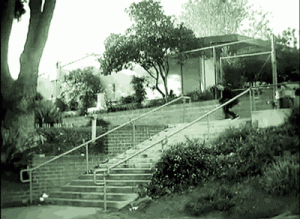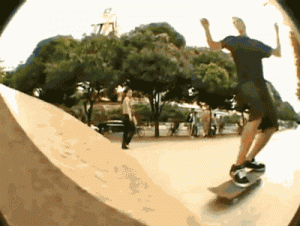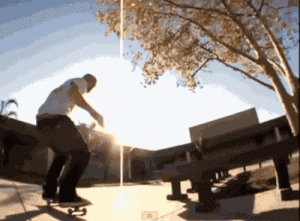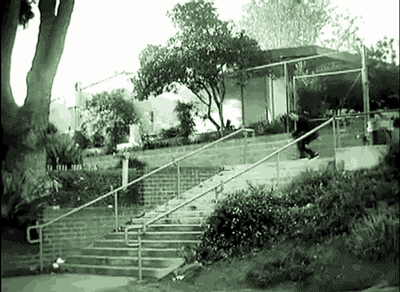
All video parts understate the difficulty of skating by presenting an endless barrage of clip after clip of tricks landed bolts. Occasionally a particularly gnarly trick will have a bail thrown into the mix in order to make the successful attempt look that much more epic. But again, that’s just occasionally.
If you follow skateboarding more closely (or, you film video parts which your humble correspondent does not do) though you’ll find a different story. You’ll hear about whole days spent at a ledge in Barcelona trying to make a single trick and not getting it then coming back 2 months later and spending another week trying to roll away from the same trick (keep in mind that there’s not just the skater, there’s a filmer spending whole days trying to capture the trick on video). You read about ankles getting sprained trying to frontside flip a 16-stair set and having to take 3 weeks off to heal only to come back right back to it when the ankle is better. If you pay close attention you’ll notice someone has a different outfit on for the 2nd angle shot of a particularly difficult trick, meaning it was so hard that when they finally made it they either couldn’t make it again or didn’t have it in them to try again that day. And as you become more familiar with the spots in videos you’ll notice that a single trick in someone’s part was filmed in China.
Think about that, a trip to China to get one 4-second clip of a trick on a marble ledge.
Think about that, a trip to China to get one 4-second clip of a trick on a marble ledge. Of course more went into it than flying to China, jumping off the plan, filming a clip, and then coming back to the States. There’s the dozens of attempts to get that clip. There were all the other days spent battling for other tricks that never panned out. Maybe you just couldn’t stick the landing or maybe it seemed like you got a clip every day but when it was time to edit the part nothing stood out as note-worthy.
The final video part is a just fraction of what the skater puts into it. Its the 80/20 rule taken to an extreme, more like the 99/1 rule. 1% of all the work you put in makes it into the video. A year-and-a-half, two years, three years maybe but just 1% of that work makes into the video.
There’s two things that fascinate me about the video part because they’re universal: 1) To get the clips you have to show up, and 2) you cannot rush it.
Showing Up

You can’t get clips in your apartment, at the coffee shop, the bar or even at a skatepark. You have to make plans to hook up with a filmer, find a spot and skate. Not only do you have to skate but you have to try stuff. You have to burn through your go-to tricks. If its spot that’s already been seen in a bunch of videos then you have to try and do something new there or at least different.
There’s a few reasons why companies fund filming trips but the most significant is that it gets everyone to show up. When you’re in China with 8 of your teammates (and friends) to film for the new video its a lot harder to skip a couple days because you’re not “feeling it”. If not now, then when would you be “feeling it”? When you’re not surrounded by beautiful marble ledges and your best friends with nothing to do but skate?
If not now, then when would you be “feeling it”? When you’re not surrounded by beautiful marble ledges and your best friends with nothing to do but skate?
I doubt that I need to point out the obvious here but if you’re trying to get something done you have to show up and put in work. Meetings don’t get things done, brainstorming doesn’t get things done, talking doesn’t get things done. At some point, you have to show up to the place where you do your work whether its a set of stairs in Hollywood, a ledge in Barcelona or a text editor on your laptop and you have to do the actual thing that will get results. No one gets paid for being a writer—they get paid for the delivery of articles and books.
You Cannot Rush It

Marc Johnson put together a three-song part for Fully Flared. That’s 13 minutes of clips. I haven’t counted but my rough guess is that this part contains upwards of 100 tricks filmed over a period of about five years. In that time he spent hundreds of hours on a skateboard and while 13 minutes is an epic length for a video part, its ultimately a quick skate to the coffee shop. But it takes that long to film in order to get 13 minutes of footage. It takes trips to Barcelona, to France, to China and driving across the country twice. It takes time to find new spots to skate and it takes time to come up with new tricks for old spots. When Marc started filming for Fully Flared he didn’t plan to make a three-song part but the clips just build up over time. Three seconds here and eight seconds there and slowly something interesting starts to take shape.
…while 13 minutes is an epic length for a video part, its ultimately a quick skate to the coffee shop.
Its an interesting dualism—you can’t wait for inspiration but you can’t rush it either. You just set up the optimal conditions for working and you show up ready to work. One day you’ll get 3 clips or 4 pages or 2 songs or 10 ideas and the next week you get shit. It’ll all be garbage. But if you just keep showing up and keep working the results will add up.
Ultimately, the biggest lesson is this: you have to get one clip at a time and you have to start now. A trip to China is nice but not necessary.
Author: Namdev Hardisty
